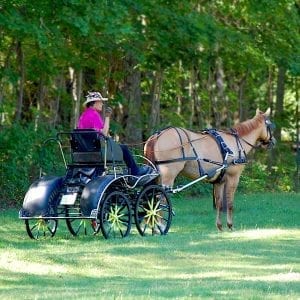 The most valuable skill you can teach a horse is to stand still. You may think that’s an overstatement but it’s not even the slightest exaggeration. You can accomplish more in all of your training by giving your horse “the skill of being still.”
The most valuable skill you can teach a horse is to stand still. You may think that’s an overstatement but it’s not even the slightest exaggeration. You can accomplish more in all of your training by giving your horse “the skill of being still.”
Unfortunately, many people fall into the trap of thinking that patience is something that a horse just has, or doesn’t have. That leads them to believe that standing is something the horse is “willing” or “unwilling” to do. Nothing could be further from the truth!
Patience, and standing are skills that you can teach any horse (yes, I really do mean any horse!) The training teaches the horse how to focus on their person and follow that person’s cues rather than doing whatever pops into the horse’s head.
With some focused attention, you can get more done on this subject than you might think possible. Here are a few tips to get your horse to stand for you whenever you need him to.
Set Stand as a Specific Training Goal
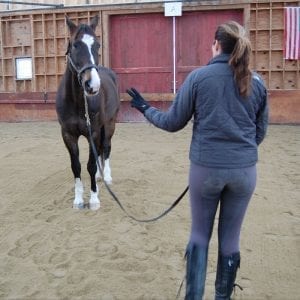
It seems that people set their horses up for failure even before they begin. They complain that “he doesn’t stand when he’s being groomed, tacked, at the mounting block, or hitching area.” They want the horse to stand in all of those circumstances, but they haven’t ever taught the horse the skill of being still!
You must first teach the horse that the act of immobility is actually a really big accomplishment. In order to explain that to your horse, you have to eliminate all other activities from the mix, and only focus on asking him to be still. That way when you reward him for his accomplishment, there’s no doubt in his mind what it was that he was doing right.
These training sessions can be short 10-15 minute sessions. The trick is to quit when you’re ahead. Perhaps all you’ll accomplish the first step of having him stand in one spot for 2 minutes while you’re relatively close by his side. That’s progress!!
Congratulate your horse for his success and let him off the hook. Return him to his stall, or turn him out with his buddies. Believe it or not, your horse will notice. Each time you return to the exercise, you’ll find your way to that success more quickly, and you’ll be able to add more to it.
First you’ll start adding more time to his stillness, then space between you and your horse. As he gets really good at it, you can start adding grooming and tack into the mix. The important thing is to remember that the stand is the focus of the training, rather than the side note.
Stand In One Place
It’s not enough to ask the horse to stop moving. If he steps away from the place you’ve asked him to stand, you should return him as exactly as possible to the spot he was to be standing upon. I mean exactly.
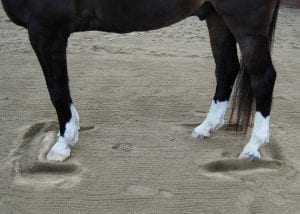
This may seem like a trivial, but horses quickly begin to attach importance to “that one spot.” The meaning of that spot grows, the more insistent you become on that being the only acceptable place to stand.
In fact, the clever ones will try to avoid stand just exactly the spot once they’ve figured it out. They’ll put 3 feet in, but leave one out, just to prove that they don’t really have to do it.
Stick to your guns, and get him back to that spot exactly. When you do, the mythical power of that spot will glue your horse’s feet to the ground (well, in his mind anyway.)
Don’t Hold Your Horse!
This may be one of the more difficult pieces of coaching for people to understand. After all, it just feels natural to hold your horse if you want him to stand still.
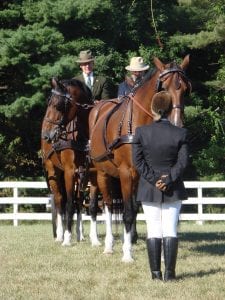
Certainly as you begin to focus on teaching your horse how to stand still, you’ll likely have to start out in a position right next to him. However, your goal should be to graduate to more hands-off, remote positions.
When I’m teaching a horse to stand, I start the first session with a very long lead rope. Each time I return him to being still, I step well away from him toward the end of that rope. As we build success, we graduate to a lunge line, and I change positions in an exercise I call “Around The World.”
If I have to correct the horse for moving, I first correct him verbally, then with body language from several feet away. If he complies, I keep my distance. This “Around the World” training gives you a kind of remote control for your horse. When you can get him to be still from 10 yards away, getting him to be still for mounting or hitching is easy!
Keep Training!
As you can see in my course materials for Teach Your Horse to Stand, each step along the way needs specific attention. You start in the barn, then move to grooming, tacking up, hitching or mounting and so on, each in their own focused sessions.
As you build your horse’s skill for being still, the training will begin to improve all of your experiences with your horse. He’ll be more patient on the cross ties for grooming and tacking. He’ll wait for you to mount and be less likely to fidget when you need to stop in the middle of a workout.
Most importantly, you’ll have your horse’s full attention from when you first take him out of the stall throughout all of your training. That leads better communication and more willing compliance in all of your training.
Those may sound like long promises for such a simple activity, but I’ve seen the results. Drivers and riders of all disciplines have shared stories with me not only about how well their horses stand, but how much their training improved after training this skill.
Have You Used This Training?
Have you taken the “Teach Your Horse to Stand” class, or used the lesson plans to get your horse or pony standing still? Tell us what you think the most important lesson you learned while training this skill. Share your success, thoughts and perspective in the comments section below. Everyone will benefit from your input!
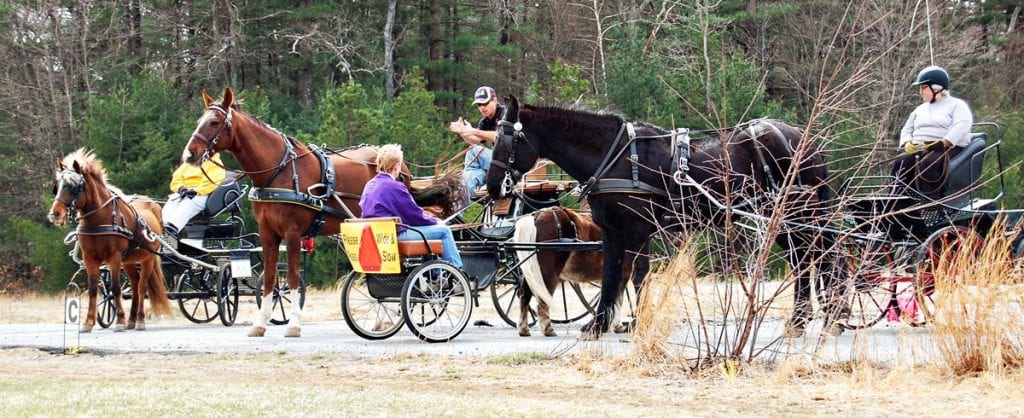


Teaching our well broke to ground drive and ride, gallop jump, pony stallion to stand to be put to or have vehicle taken away, or to dismount, run up irons, loosen girth etc has been a VERY valuable lesson. He is distracted easily or should I say very aware of his surroundings, but not spooky (if that makes sense?) he’s not bolted nor scooted very far ever, but being taught to stand, gives the pause he needs to refocus. The driving training really reinforced the pretty good stand training he had to Stand like your hooves are growing roots into the ground, standing. It is odd that when he is tied to or facing a trailer, he screws around more than when he is standing open facing down the driveway. It is as if he can see more and stands better. Still we need to work more on standing when I am on the seat.
Something that is lost in training on horses (mostly due to their size, im afraid) is that they are JUST as teachable as a dog, uf nor more so due tontheir extreme sensitivity to the slightest change in intonation/body language/ confidence in their teacher…the paradigms of kindness/patience/CONSISTENCY(capitalized for a reason)/repetition are KEY to teaching a horse anything…
I woukd love to someday come and learn some of the finer points of driving at a clinic someday
My horses are good at staying but when in harness and I stop them, they go into fidget mode. The gelding mouths the reins and chews on the neck yolk, thus catching the reins over the end of the pole. What can I do about this? Thank you!
The key is to set time aside to train that specific skill. In this case, you’re looking to get your horses to remain in their neutral body position, as I outline in the Teach Your Horse to Stand class.
The first step would be some ground training, where you focus on the fidgets. Each time they begin to fidget, you give a verbal cue to stop. That can be the classic “Aaaghh!”, or something like “Head UP!” Really, it doesn’t matter what the verbal cue is as long as you are consistent with it.
You can do this training with, or without harness on, but don’t hitch. Just focus on building the correction. Do relatively short sessions. End when you have a sustained period of compliance (that means different things for different horses. It could be 3 minutes, or it could be 10 minutes.) Put them away when you’re done with that session. Let it sink in.
When you want to apply that training to work in the carriage, again, you have to go out with the clear goal of working that specific skill. You’re not going out for a drive, you’re going out for a stand!
Again, when you’ve gained a period of compliance, END the training session!
That’s the difference between methodical training, and training at your convenience. It takes human discipline to impart equine discipline.
There’s more on this in the 3rd lesson plan in the stand lesson plan series “Stand Working.”
While it’s tempting to skip right to that lesson plan, I can’t stress enough that doing the groundwork from the previous two lesson plans is the key to success.
Just returned from a Navigator’s Clinic with Keith Yutsy. He also emphasized the importance of teaching the horse to stand for safety. It’s critical!
Thanks for emphasizing. Enjoyed the article.
Keith is someone I’ve always enjoyed working with. I’m glad to hear we are teaching the same principles.
I have been teaching “be still and wait” to riding and driving horses for 60 years. I like “HO” to be carved in stone. It does not matter if they are just haltered, fully tacked or hitched and ready to go…. They stand and wait, where put, while I get something from the barn, go adjust an obstacle, get a drink, or rush to the aid of someone else… It is a skill I impart from the very first moments of training, because like anything else it is easier “writing on a clean slate” and fresh young minds accept more quickly new input. Every horse should know how to be still, his and your life could depend on it. A horse who will “stay” is a pleasure to work with, and isn’t that why we work with them… for the joy it gives us. While you are at it, add a few other “dog” commands; like “come”, “go”, “over” and “heel” they come in handy.
Deborah,
I liked your response – Especially the reminder of teaching DOG commands. That sticks. Thank you for sharing.
Karla Moyer
Agree 100% with you Karla!
In fact, I was just writing something that, in a way, relates.
People often underestimate the level of complexity of what’s achievable with horses. We think of dogs as being able to learn those things, but are amazed when we see a performer who can use similar requests with horses.
I think I wrote something to the effect of:
The limit is: there is no limit to what our horses can learn.
WONDERFUL article. Such valuable information to keep drivers and their partners safe and happy. Thank you
YES! My horses ground tie in the barn from the time they are babies. It is essential training, especially when you work alone 99% of the time….Great article, thank you!! Glad you are on the mend!
This article is so very important. My driving pony will stand like a rock when I hitch him and when I stop him while driving. I completely forgot about teaching this to my young gelding that I ride. Instead of taking the time to teach him to stand while I groom and tack him up, I have just been tying him. He may be a future driving horse, so I will use this winter to teach him to stand. Thank you for the reminder.